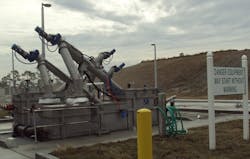Getting to the Grit of It
You can reach Lakeside Equipment Corp. at www.lakeside-equipment.com or 630.837.5640.
undefinedWith an estimated 10% of Florida’s 2 to 3 million septic tank systems not working properly, there is an understandable concern about pollution to bodies of water such as the Indian River Lagoon on the east coast near Vero Beach, Fla.
With some tanks currently emptied only every 15 years contributing to nutrient and fecal coliform bacteria in groundwater, the general assembly is working to introduce laws that would require inspection and emptying of tanks every three to five years.
In Brevard County, for example, which accounts for 71% of the lagoon, there are 82,000 permitted septic systems. According to a legislative staff analysis, 59,500 of those tanks pollute groundwater that flows into the estuary. That pollution contributed to the algae blooms that killed fish in the Banana River and northern lagoon.
New legislation would undoubtedly see an increase in volume at treatment plants such as Indian River County’s Residuals Dewatering (Biosolids) Facility (RDF), which has become known for its efficiency. Recent analysis showed that approximately 66% of the hauled waste brought to the site by septic haulers was not actually generated in Indian River County itself. These wastes came from commercial, industrial and municipal sources in addition to residential septic tank cleanings located in nearby counties. Planned and built to serve the needs of the Indian River County residents whose taxes pay for it, the RDF no longer accepts out-of-county haulers that previously traveled to the facility from up to 100 miles away.
Despite receiving large volumes (100,000 gal) of septage from 30 to 35 vacuum trucks on a daily basis, Indian River’s RDF has been a pillar of strength since it opened in 2010. The facility’s team has made an exceptionally strong case for justifying the high specification of the equipment it chose. The lowest bid did not win.
“For grit removal, we looked at several manufacturers and visited quite a few sites, but for a system that was truly built for purpose, Lakeside’s complete plant sets itself apart,” said Rich Meckes, Indian River County’s RDF manager. “Everything is rugged, and it is also far easier to access than others we looked at. You can open up the top cover and all the maintenance points are very conveniently located.”
According to Meckes, it captures more grit and rags than anticipated. The company will fill a 4-yard dumpster every day—sometime more than one per day. The septage plant is extremely tough and can handle pretty much everything that comes its way.
“The conditions it operates under are crazy, but in nearly a decade, there have been no bearing failures, and we have only had to carry out very basic daily maintenance,” Meckes said. “It doesn’t always need a clean. Another great thing about the machine is its overnight self-cleaning cycle. This stops the buildup in the bottom of the unit, which is very helpful. Overall, we’re very happy with it, and as a company, Lakeside have been very easy to work with.”
Meckes said the facility did not anticipate getting 10 years of service from the combined screen and grit removal system.
“If you can get a decade out of any equipment on a tough application at a wastewater treatment plant, without any major problems, you know you’ve bought right,” Meckes said. “Considering the abuse that the Lakeside septage complete plant has taken, it has been a great buy”.
